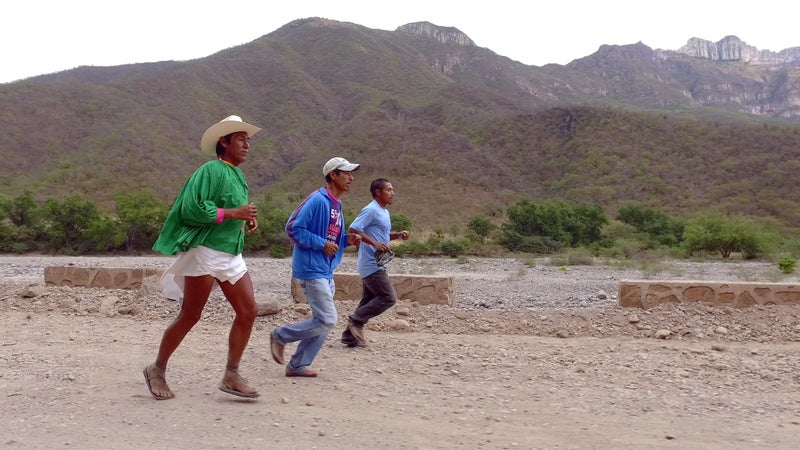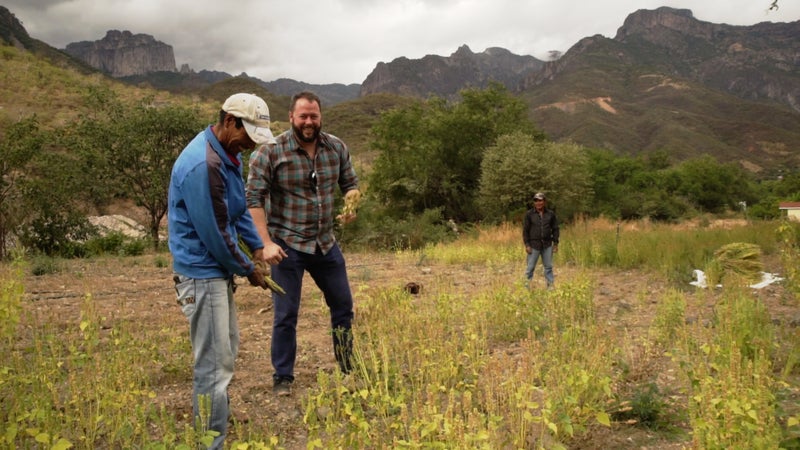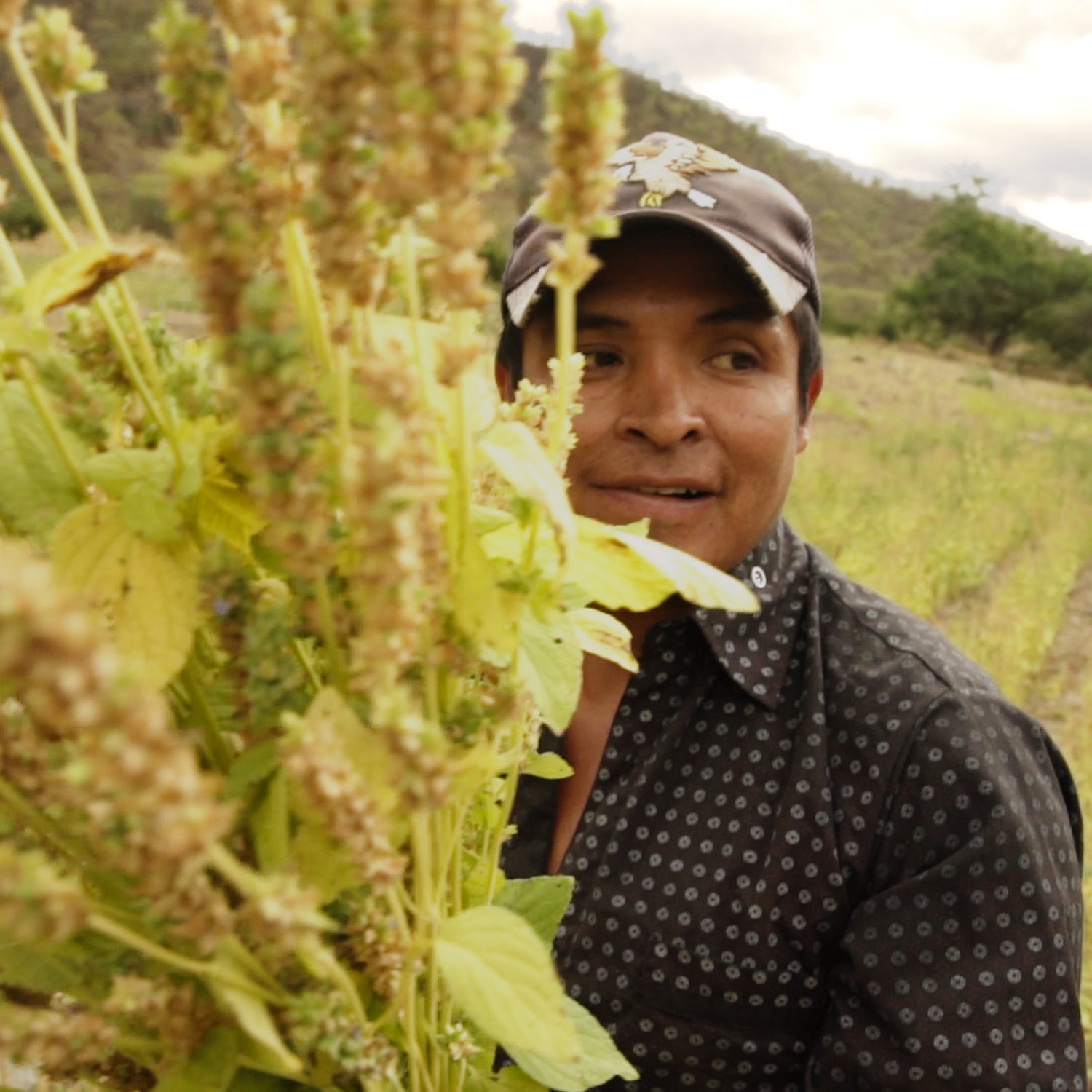I was having a moment straight out of Born to Run in the most literal sense. Arnulfo Quimare, one of the best ultrarunners in the world (and star of Born to Run), was steadily dropping me as we traced a trail through Mexico’s stunning Copper Canyon (the setting of Born to Run). We were running up a dry creek bed with stones the size of pomelos rolling underfoot.
I had come all this way (two planes, two vans, and a train) to see a new agricultural project happening in the canyon, but I couldn’t pass up the opportunity to run with Quimare first—even if he was now easily bounding over the stones ahead of me as I kept my eyes on the uneven ground. My slow pace paid off when I spotted a spindly wild chia stalk, packed with seeds, growing in a gap between two water-worn boulders. This plant was the reason I’d come all this way.
Christopher McDougall’s 2009 bestseller, Born to Run, introduced Americans to the Tarahumara people, a tribe of ultra-athletes who live in Copper Canyon. It also introduced many readers to chia. The tiny black seeds received only a multisentence mention—McDougall describes a chia-water mixture as and a great recovery aid—but it launched a thousand Google searches. I asked McDougall why he thinks those few sentences stuck out to so many people. “Until then, runners had been told over and over that they needed high-tech, processed stuff like cushioned shoes and PowerBars,” he says. “Chia and bare feet suddenly offered a cheap, traditional alternative that was actually more effective.”
Thanks to Americans’ fascination with the ultrarunning lifestyle of the Tarahumara, Copper Canyon saw a temporary bump in tourism after the book came out. But in the past few years, a lethal drought and torrent of drug-related violence delivered a one-two punch to the canyon’s people and their crops.

Now, a partnership forged over a love of McDougall’s book could contribute some economic stability to the area. A chia-centric energy bar company and local farmers are working together to take advantage of America’s obsession with the very plant I just ran past.
Chia seeds aren’t actually an important part of most Tarahumaran people’s diets. Corn is one of the main staples, usually ground into cornmeal and mixed with water to form a thick porridge. Most people in Copper Canyon grow their own corn in small backyard plots and live as subsistence farmers. But the subsistence life can be insecure, especially in a canyon prone to drought. In 2011, all of Mexico received less rainfall .
Mickey Mahaffey, an expat farmer who lives in Copper Canyon and is married to a Tarahumara woman, remembers showing up at a race and seeing just how dire things were for many of his neighbors. “They were too weak to run. They’d had nothing to eat,” he says.
For years, Mahaffey has been looking for a way to make life in the canyons more economically viable. Logging has been one of the main industries, but it’s wrecking the local ecosystem. Running drugs, picking poppies, or allowing poppies to grow on their land have all become lucrative for the Tarahumara since cartels have come to the area to cash in on America’s opioid addiction. A reported that some Tarahumara drug mules made $800 for every load of drugs they ran across the border—more than many would make in an entire year. Of course, there’s no guaranteeing the drug cartels will actually pay, and it’s a dangerous business to get mixed up in.
While Americans were buying Vibram FiveFingers and noshing on chia seeds, the Tarahumara were leaving the lifestyle that we were all trying to emulate.
Mahaffey says that as many as 10,000 of the 50,000 to 70,000 total Tarahumara moved to the city of Chihuahua to find jobs. “There, they’re basically refugees,” he says. They face racism and extreme poverty; the average wage in the city is $5 to $6 a day.
They also lose their lean running physiques. “When you live in the city, you stop walking, and many aren’t running as much or don’t run at all,” says Irma Chavez, a champion Tarahumara runner who now lives in Chihuahua. A in Human Biology found that Tarahumara boys living in cities had obesity rates that were almost double their rural counterparts. Girls in cities suffered from obesity at quadruple the rate of those still living in the canyons.
Since 2014, Mahaffey has been trying to get organizations to fund a small-scale, pre-Columbian agricultural project in the canyon, but to no avail. Then, he met three aging college athletes turned nutrition nerds at the 2016 Boston Marathon.
Nick Morris, Dan Gluck, and Shane Emmett started the Richmond, Virginia–based chia energy bar company in 2010, inspired by the simple health philosophies of Michael Pollan’s book The Omnivore’s Dilemma, as well as Born to Run. They were so directly inspired by the Tarahumara in creating their bars (the first widely available chia-centric bar) that they wanted to give back in some way. In 2011, Emmett tracked down an email address for Caballo Blanco, also known as Micah True, another key ultrarunner in McDougall’s book. The two were forming a charity partnership when True died during a run in 2012. “And then the effort kind of fell off because we didn’t have a contact there,” says Emmett.

All of these facts came together, funnily enough, at McDougall’s booth at the 2016 Boston Marathon. McDougall was promoting his new book, ; Mahaffey was visiting the race with a few Tarahumara runners; and the Health Warrior guys were promoting the company while looking for ways to import chia seeds. McDougall made the introduction. Emmett asked Mahaffey if he could grow chia seeds for Health Warrior.
Health Warrior paid for the first crop in cash, and Mahaffey recruited neighbors to help with the planting process. He wants the initiative to be as minimally disruptive to the canyon as possible—they use mule plows to work the land, for example. All of the Tarahumara growers and harvesters make fair wages for their work. Mahaffey says that the average wage in the area is about 100 pesos a day, but they pay 300 pesos a day, plus three meals and lodging since many workers come from miles away. Silvino Cubesare, a Tarahumara runner who works closely with Mahaffey on the Health Warrior project, says the farm provides much-needed jobs in the area. “With this project, we have good pay and don’t have to leave home to look for work in other places, and we get to do what we do best—farm.”
Emmett says that, yes, the 1,000 pounds of chia seeds resulting from the first harvest are pricier than what Health Warrior could have imported from established growers. But it’s worth it to the company. In fact, Health Warrior plans to continue the project next year and would like to expand to more than one farm site.
Health Warrior in January to sell special Mexican chocolate bars made from this year’s harvest. All proceeds from the bars sold on Kickstarter will be reinvested into Mahaffey’s program, which will be called Operation Farm & Run. Whole Foods also ordered the Mexican chocolate flavor to sell in all of its stores, and 10 percent of those sales will go toward Operation Farm & Run. The goal is to start several microfarms around the canyon. Emmett anticipates a start-up cost of about $10,000 per farm; as of publishing, the Kickstarter campaign has raised more than $12,000 toward the $40,000 goal.
Neither Mahaffey nor Emmett have any desire to take this program so far that Mexico’s Copper Canyon becomes the world’s next great chia seed exporter. The whole point of the initiative is to make the Tarahumara’s traditional way of life economically viable. Importing tractors and moving to monocultures instead of small, diverse backyard plots would be self-defeating. “The Tarahumara love their culture. They know how special it is,” says Mahaffey. “I want to help the Tarahumara be able to stay here if they want to.”


